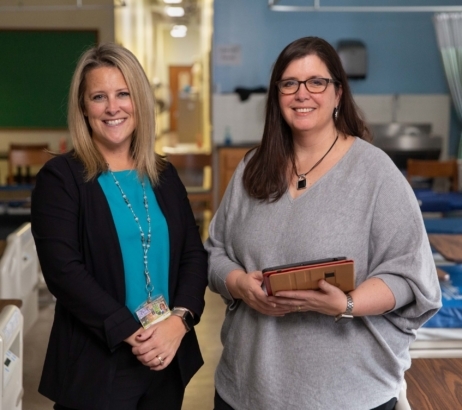February 9, 2022
Changing Healthcare with a Screen: A Closer Look at Project Indigo through a Nursing Lens
The next generation of healthcare heroes depends on technology to keep themselves and their patients safe. From intake to discharge, nurses are connected to their colleagues, doctors, patients, and patient families through a screen. Thanks to Project Indigo, Capital nursing students are prepared to take the next step in their career and embrace technology in their chosen field.
Through Project Indigo, students, staff, and faculty have access to their own eighth-generation Apple iPad, first-generation Apple pencil, and a library of individualized apps. The digital tools were designed to enhance learning and transform the educational experience by learning new ways to collaborate with colleagues, faculty, and staff.
Maria Satre, M.S.N., instructor in nursing, and Lynn Segovia, M.S.N., instructor in nursing, work together to co-teach N365 Families in Transition and have found their iPads an essential part of the classroom experience.
“I will say from an instructor standpoint, having an iPad has been nice in a couple of different ways,” said Satre. “I can be mobile around the classroom and it allows me to really work and interact with students without being stuck in the front. I just bring my iPad with me around the room, so that’s been really helpful.”
Both instructors use Nearpod in the classroom, and the real-time insights it offers have helped modify their day-to-day plans. From interactive presentations to class discussions based on polling results, the instructors are able to gauge the students’ understanding of concepts during lectures rather than waiting for a test.
“It gives us more immediate feedback. We can kind of see as we move along if students are getting it. Then maybe we can move on, or maybe we can go deeper into a concept if it feels like they already have a basic understanding of the concept,” said Segovia.
The iPads can be used as a personal learning tool and an instrument to encourage a collaborative classroom environment.
“I develop interactive presentations and then share a code to that presentation with the students. For me, I direct what’s on their screen when they’re using their iPad, so I change the slide flow,” said Satre. “I also put up collaborative activities like collaboration boards where they can add sticky notes all over the board to jump off a class discussion.”
Real-world experience is critical training for nursing students at Capital. The nursing simulation room gives students the hands-on experience of working in a real clinic setting. Both Satre and Segovia have incorporated the iPad into the learning experience for students.
“Using OneNote, we created a sample electronic medical record form inspired by Epic, which is a system a lot of our hospitals are using. It’s a similar flow in pictures without all the background database technology, but it works for us,” said Satre. “I can set it up to look like a patient chart, where I have a section for patient vital signs, patient labs, etc.”
Practice with a sample patient chart will allow nursing students to be more competitive and prepared in the next step of their careers.
“The patient chart is live so students can type information in and it shows up on my view, or if I type information, it shows up in their view. For example, if I want to put lab results, I can add those in real time, and the students can see the results while in the nursing simulation,” said Segovia. “I’m grateful for what Capital has done with Project Indigo and that they are trying to bring technology into the classroom.”
To learn more about Capital’s Nursing program, go to https://www.capital.edu/academics/majors-and-minors/nursing/.
To learn more about Project Indigo, go to https://apps.capital.edu/indigo/.


